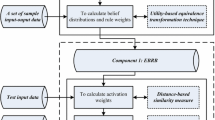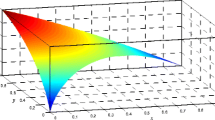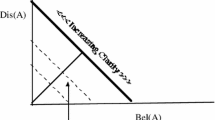Abstract
Focusing on the problem that current belief rule-based system cannot effectively deal with interval uncertainty, this paper investigates the belief rule-based system under overall interval uncertainty, where interval data, interval belief degree, and grade interval are considered simultaneously, and the interval belief rule-based system (IBRBS) is proposed based on the analysis. Firstly, the interval belief rule base (IBRB) was established with interval belief distributions embedded in both the antecedent and consequent terms of each rule, which is capable of capturing interval uncertainty and incompleteness in an integrated way. Then, the activation weight calculation method using the nonlinear optimization model is proposed, and the analytical interval evidential reasoning (IER) algorithm is applied as the inference method to combine activated rules under interval uncertainty. Finally, two case studies are presented to illustrate the effectiveness of the proposed method. Results show that the proposed method can be regarded as the generalized form of belief rule-based system, and could effectively deal with interval uncertainty.



Similar content being viewed by others
References
Sun R (1995) Robust reasoning: integrating rule-based and similarity-based reasoning. Artif Intell 75(2):241–295. https://doi.org/10.1016/0004-3702(94)00028-Yhttps://doi.org/10.1016/0004-3702(94)00028-Y
Rodriguez-Lozano FJ, Guijo-Rubio D, Gutierrez PA, Soto-Hidalgo JM, Gamez-Granados JC (2021) Enhancing the orca framework with a new fuzzy rule base system implementation compatible with the jfml library. In: 2021 IEEE International conference on fuzzy systems (FUZZ-IEEE). IEEE, pp 1–6
Guan Y, Fu Y, Chen L, Liu G, Sun L (2021) Belief-rule-base inference method based on gradient descent with momentum. IEEE Access 9:34487–34499
Chang L, Zhang L, Fu C, Chen YW (2021) Transparent digital twin for output control using belief rule base. IEEE Transactions on cybernetics
Gao F, Zhang A, Bi W (2020) Weapon system operational effectiveness evaluation based on the belief rule-based system with interval data. J Intell Fuzzy Syst 39(5):6687–6701. https://doi.org/10.3233/jifs-190651
Gao F, Zhang A, Bi W, Ma J (2021) A greedy belief rule base generation and learning method for classification problem. Appl Soft Comput 98:106856. https://doi.org/10.1016/j.asoc.2020.106856
AbuDahab K, ling Xu D, wang Chen Y (2016) A new belief rule base knowledge representation scheme and inference methodology using the evidential reasoning rule for evidence combination. Expert Syst Appl 51:218–230. https://doi.org/10.1016/j.eswa.2015.12.013https://doi.org/10.1016/j.eswa.2015.12.013
Sun C, Yang R, He W, Zhu H (2022) A novel belief rule base expert system with interval-valued references. Sci Rep 12(1):1–14
Zhang A, Gao F, Yang M, Bi W (2020) Belief rule-based dependence assessment method under interval uncertainty. Qual Reliab Eng Int 36(7):2459–2477
Zhang A, Gao F, Yang M, Bi WH (2020) A new rule reduction and training method for extended belief rule base based on dbscan algorithm. Int J Approx Reas 119:20–39. https://doi.org/10.1016/j.ijar.2019.12.016https://doi.org/10.1016/j.ijar.2019.12.016, <Goto ISI>://WOS:000517653700002
Yang JB, Liu J, Wang J, Sii HS, Wang HW (2006) Belief rule-base inference methodology using the evidential reasoning approach-rimer. IEEE Trans Syst Man Cybern-part A: Syst Humans 36(2):266–285. https://doi.org/10.1109/TSMCA.2005.851270
Cao Y, Zhou ZJ, Hu CH, Tang SW, Wang J (2021) A new approximate belief rule base expert system for complex system modelling. Decis Support Syst 150:113558
Zhang MJ, Wang YM, Li LH, Chen SQ (2017) A general evidential reasoning algorithm for multi-attribute decision analysis under interval uncertainty. Eur J Oper Res 257(3):1005–1015. https://doi.org/10.1016/j.ejor.2016.08.028
Chang L, Chen Y, Hao Z, Zhou Z, Xu X, Tan X (2019) Indirect disjunctive belief rule base modeling using limited conjunctive rules: two possible means. Int J Approx Reason 108:1–20
Ye FF, Wang S, Nicholl P, Yang LH, Wang YM (2020) Extended belief rule-based model for environmental investment prediction with indicator ensemble selection. Int J Approx Reason
Li G, Zhou Z, Hu C, Chang L, Zhou Z, Zhao F (2017) A new safety assessment model for complex system based on the conditional generalized minimum variance and the belief rule base. Saf Sci 93:108–120. https://doi.org/10.1016/j.ssci.2016.11.011
Lin YQ, Fu YG, Su Q, Wang YM, Gong XT (2017) A rule activation method for extended belief rule base with vp-tree and mvp-tree. J Intell Fuzzy Syst 33(6):3695–3705
Bi W, Gao F, Zhang A, Bao S (2022) A framework for extended belief rule base reduction and training with the greedy strategy and parameter learning. Multimed Tools Appl, 1–17
Yang Y, Fu C, Chen YW, Xu DL, Yang SL (2016) A belief rule based expert system for predicting consumer preference in new product development. Knowl-Based Syst 94:105–113. https://doi.org/10.1016/j.knosys.2015.11.012
Zhang J, Jiang J, Chen Y, Yang K (2015) A belief rule-based safety evaluation approach for complex systems. Math Probl Eng, 2015. https://doi.org/10.1155/2015/207469
Zhou ZJ, Chang LL, Hu CH, Han XX, Zhou ZG (2016) A new brb-er-based model for assessing the lives of products using both failure data and expert knowledge. IEEE Trans Syst Man Cyberne: Syst 46(11):1529–1543. https://doi.org/10.1109/TSMC.2015.2504047https://doi.org/10.1109/TSMC.2015.2504047
Liu J, Martinez L, Calzada A, Wang H (2013) A novel belief rule base representation, generation and its inference methodology. Knowl-Based Syst 53:129–141. https://doi.org/10.1016/j.knosys.2013.08.019https://doi.org/10.1016/j.knosys.2013.08.019
Kabir S, Islam RU, Hossain MS, Andersson K (2020) An integrated approach of belief rule base and deep learning to predict air pollution. Sensors 20(7):1956
Feng Z, Zhou ZJ, Hu C, Chang L, Hu G, Zhao F (2018) A new belief rule base model with attribute reliability. IEEE Trans Fuzzy Syst 27(5):903–916
Fu YG, Zhuang JH, Chen YP, Guo LK, Wang YM (2020) A framework for optimizing extended belief rule base systems with improved ball trees. Knowl-Based Syst 210:106484
Zhou Z, Feng Z, Hu C, Hu G, He W, Han X (2020) Aeronautical relay health state assessment model based on belief rule base with attribute reliability. Knowl-Based Syst 197:105869
Hu GY, Zhou ZJ, Hu C, Zhang BC, Zhou ZG, Zhang Y, Wang GZ (2020) Hidden behavior prediction of complex system based on time-delay belief rule base forecasting model. Knowl-Based Syst 203:106147
Chang L, Zhang L, Xu X (2021) Correlation-oriented complex system structural risk assessment using copula and belief rule base. Inform Sci 564:220–236
Yin X, Zhang B, Zhou Z, Han X, Wang Z, Hu G (2018) A new health estimation model for cnc machine tool based on infinite irrelevance and belief rule base. Microelectron Reliab 84:187–196
Asadi R, Ghatee M (2015) A rule-based decision support system in intelligent hazmat transportation system. IEEE Trans Intell Transp Syst 16(5):2756–2764. https://doi.org/10.1109/TITS.2015.2420993https://doi.org/10.1109/TITS.2015.2420993
Calzada A, Liu J, Wang H, Kashyap A (2015) A new dynamic rule activation method for extended belief rule-based systems. IEEE Trans Knowl Data Eng 27 (4):880–894. https://doi.org/10.1109/TKDE.2014.2356460https://doi.org/10.1109/TKDE.2014.2356460
Calzada A, Liu J, Wang H, Nugent C, Martinez L (2015) Application of a spatial intelligent decision system on self-rated health status estimation. J Med Syst 39(11):138. https://doi.org/10.1007/s10916-015-0321-4https://doi.org/10.1007/s10916-015-0321-4
Jiao L, Pan Q, Denoeux T, Liang Y, Feng X (2015) Belief rule-based classification system: extension of frbcs in belief functions framework. Inform Sci 309:26–49. https://doi.org/10.1016/j.ins.2015.03.005https://doi.org/10.1016/j.ins.2015.03.005
Bi W, Gao F, Zhang A (2021) A novel weapon system effectiveness assessment method based on the interval-valued evidential reasoning algorithm and the analytical hierarchy process. IEEE Access 9:53480–53490. https://doi.org/10.1109/ACCESS.2021.3071419https://doi.org/10.1109/ACCESS.2021.3071419
Bi W, Gao F, Zhang A, Yang M (2020) Dependence assessment in human reliability analysis based on the interval evidential reasoning algorithm under interval uncertainty. IEEE Access 8:222187–222198. https://doi.org/10.1109/access.2020.3043848
Fu C, Yang SL (2011) Analyzing the applicability of dempster’s rule to the combination of interval-valued belief structures. Expert Syst Appl 38(4):4291–4301. https://doi.org/10.1016/j.eswa.2010.09.097https://doi.org/10.1016/j.eswa.2010.09.097
Fu C, Yang S (2012) The combination of dependence-based interval-valued evidential reasoning approach with balanced scorecard for performance assessment. Expert Syst Appl 39(3):3717–3730. https://doi.org/10.1016/j.eswa.2011.09.069
Wang YM, Yang JB, Xu DL, Chin KS (2006) The evidential reasoning approach for multiple attribute decision analysis using interval belief degrees. Eur J Oper Res 175(1):35–66. https://doi.org/10.1016/j.ejor.2005.03.034https://doi.org/10.1016/j.ejor.2005.03.034
Xu DL, Yang JB, Wang YM (2006) The evidential reasoning approach for multi-attribute decision analysis under interval uncertainty. Eur J Oper Res 174(3):1914–1943. https://doi.org/10.1016/j.ejor.2005.02.064https://doi.org/10.1016/j.ejor.2005.02.064
Zhu H, Zhao J, Xu Y, Du L (2016) Interval-valued belief rule inference methodology based on evidential reasoning-irimer. Int J Inf Technol Decis Mak 15(06):1345–1366. https://doi.org/10.1142/S0219622016500322https://doi.org/10.1142/S0219622016500322
Yang JB, Sen P (1994) A general multi-level evaluation process for hybrid madm with uncertainty. IEEE Trans Syst Man Cybern 24(10):1458–1473. https://doi.org/10.1109/21.310529
Yang JB, Singh MG (1994) An evidential reasoning approach for multiple-attribute decision making with uncertainty. IEEE Trans Syst Man Cybern 24(1):1–18. https://doi.org/10.1109/21.259681
Yang JB, Wang YM, Xu DL, Chin KS (2006) The evidential reasoning approach for mada under both probabilistic and fuzzy uncertainties. Eur J Oper Res 171(1):309–343. https://doi.org/10.1016/j.ejor.2004.09.017
Guo M, Yang JB, Chin KS, Wang HW, Liu XB (2009) Evidential reasoning approach for multiattribute decision analysis under both fuzzy and interval uncertainty. IEEE Trans Fuzzy Syst 17(3):683–697. https://doi.org/10.1109/TFUZZ.2008.928599
Jousselme AL, Grenier D, Bosse E (2001) A new distance between two bodies of evidence. Inform Fus 2(2):91–101. https://doi.org/10.1016/S1566-2535(01)00026-4
Hodges J, Bridge S, Yie S (1996) Preliminary results in the use of fuzzy logic for radiological waste characterization expert system. Mississippi State Univ, MS, Tech Rep MSU-960626
Wang TC, Chang TH (2007) Application of topsis in evaluating initial training aircraft under a fuzzy environment. Exp Syst Applic 33(4):870–880
Dagdeviren M, Yavuz S, Kilinc N (2009) Weapon selection using the ahp and topsis methods under fuzzy environment. Exp Syst Applic 36(4):8143–8151
Lin KP, Hung KC (2011) An efficient fuzzy weighted average algorithm for the military uav selecting under group decision-making. Knowl-Based Syst 24(6):877–889
Acknowledgements
This work was supported by the National Natural Science Foundation of China under Grant No. 61903305 and Grant No. 62073267.
Author information
Authors and Affiliations
Corresponding author
Additional information
Publisher’s note
Springer Nature remains neutral with regard to jurisdictional claims in published maps and institutional affiliations.
Rights and permissions
Springer Nature or its licensor holds exclusive rights to this article under a publishing agreement with the author(s) or other rightsholder(s); author self-archiving of the accepted manuscript version of this article is solely governed by the terms of such publishing agreement and applicable law.
About this article
Cite this article
Gao, F., Bi, C., Bi, W. et al. A new belief rule base inference methodology with interval information based on the interval evidential reasoning algorithm. Appl Intell 53, 12504–12520 (2023). https://doi.org/10.1007/s10489-022-04182-z
Accepted:
Published:
Issue Date:
DOI: https://doi.org/10.1007/s10489-022-04182-z




